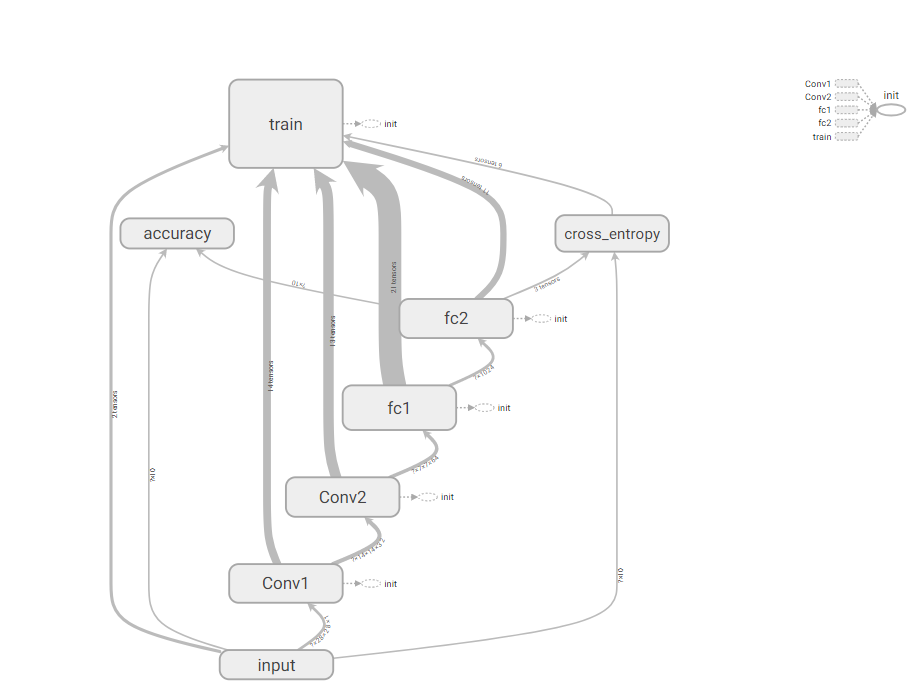TensorFlow(十):卷积神经网络实现手写数字识别以及可视化
2024-09-01 13:04:00
上代码:
import tensorflow as tf
from tensorflow.examples.tutorials.mnist import input_data mnist = input_data.read_data_sets('MNIST_data',one_hot=True) #每个批次的大小
batch_size = 100
#计算一共有多少个批次
n_batch = mnist.train.num_examples // batch_size #参数概要
def variable_summaries(var):
with tf.name_scope('summaries'):
mean = tf.reduce_mean(var)
tf.summary.scalar('mean', mean)#平均值
with tf.name_scope('stddev'):
stddev = tf.sqrt(tf.reduce_mean(tf.square(var - mean)))
tf.summary.scalar('stddev', stddev)#标准差
tf.summary.scalar('max', tf.reduce_max(var))#最大值
tf.summary.scalar('min', tf.reduce_min(var))#最小值
tf.summary.histogram('histogram', var)#直方图 #初始化权值
def weight_variable(shape,name):
initial = tf.truncated_normal(shape,stddev=0.1)#生成一个截断的正态分布
return tf.Variable(initial,name=name) #初始化偏置
def bias_variable(shape,name):
initial = tf.constant(0.1,shape=shape)
return tf.Variable(initial,name=name) #卷积层
def conv2d(x,W):
#x input tensor of shape `[batch, in_height, in_width, in_channels]`
#W filter / kernel tensor of shape [filter_height, filter_width, in_channels, out_channels]
#`strides[0] = strides[3] = 1`. strides[1]代表x方向的步长,strides[2]代表y方向的步长
#padding: A `string` from: `"SAME", "VALID"`
return tf.nn.conv2d(x,W,strides=[1,1,1,1],padding='SAME') #池化层
def max_pool_2x2(x):
#ksize [1,x,y,1]
return tf.nn.max_pool(x,ksize=[1,2,2,1],strides=[1,2,2,1],padding='SAME') #命名空间
with tf.name_scope('input'):
#定义两个placeholder
x = tf.placeholder(tf.float32,[None,784],name='x-input')
y = tf.placeholder(tf.float32,[None,10],name='y-input')
with tf.name_scope('x_image'):
#改变x的格式转为4D的向量[batch, in_height, in_width, in_channels]`
x_image = tf.reshape(x,[-1,28,28,1],name='x_image') with tf.name_scope('Conv1'):
#初始化第一个卷积层的权值和偏置
with tf.name_scope('W_conv1'):
W_conv1 = weight_variable([5,5,1,32],name='W_conv1')#5*5的采样窗口,32个卷积核从1个平面抽取特征
with tf.name_scope('b_conv1'):
b_conv1 = bias_variable([32],name='b_conv1')#每一个卷积核一个偏置值 #把x_image和权值向量进行卷积,再加上偏置值,然后应用于relu激活函数
with tf.name_scope('conv2d_1'):
conv2d_1 = conv2d(x_image,W_conv1) + b_conv1
with tf.name_scope('relu'):
h_conv1 = tf.nn.relu(conv2d_1)
with tf.name_scope('h_pool1'):
h_pool1 = max_pool_2x2(h_conv1)#进行max-pooling with tf.name_scope('Conv2'):
#初始化第二个卷积层的权值和偏置
with tf.name_scope('W_conv2'):
W_conv2 = weight_variable([5,5,32,64],name='W_conv2')#5*5的采样窗口,64个卷积核从32个平面抽取特征
with tf.name_scope('b_conv2'):
b_conv2 = bias_variable([64],name='b_conv2')#每一个卷积核一个偏置值 #把h_pool1和权值向量进行卷积,再加上偏置值,然后应用于relu激活函数
with tf.name_scope('conv2d_2'):
conv2d_2 = conv2d(h_pool1,W_conv2) + b_conv2
with tf.name_scope('relu'):
h_conv2 = tf.nn.relu(conv2d_2)
with tf.name_scope('h_pool2'):
h_pool2 = max_pool_2x2(h_conv2)#进行max-pooling #28*28的图片第一次卷积后还是28*28,第一次池化后变为14*14
#第二次卷积后为14*14,第二次池化后变为了7*7
#进过上面操作后得到64张7*7的平面 with tf.name_scope('fc1'):
#初始化第一个全连接层的权值
with tf.name_scope('W_fc1'):
W_fc1 = weight_variable([7*7*64,1024],name='W_fc1')#上一场有7*7*64个神经元,全连接层有1024个神经元
with tf.name_scope('b_fc1'):
b_fc1 = bias_variable([1024],name='b_fc1')#1024个节点 #把池化层2的输出扁平化为1维
with tf.name_scope('h_pool2_flat'):
h_pool2_flat = tf.reshape(h_pool2,[-1,7*7*64],name='h_pool2_flat')
#求第一个全连接层的输出
with tf.name_scope('wx_plus_b1'):
wx_plus_b1 = tf.matmul(h_pool2_flat,W_fc1) + b_fc1
with tf.name_scope('relu'):
h_fc1 = tf.nn.relu(wx_plus_b1) #keep_prob用来表示神经元的输出概率
with tf.name_scope('keep_prob'):
keep_prob = tf.placeholder(tf.float32,name='keep_prob')
with tf.name_scope('h_fc1_drop'):
h_fc1_drop = tf.nn.dropout(h_fc1,keep_prob,name='h_fc1_drop') with tf.name_scope('fc2'):
#初始化第二个全连接层
with tf.name_scope('W_fc2'):
W_fc2 = weight_variable([1024,10],name='W_fc2')
with tf.name_scope('b_fc2'):
b_fc2 = bias_variable([10],name='b_fc2')
with tf.name_scope('wx_plus_b2'):
wx_plus_b2 = tf.matmul(h_fc1_drop,W_fc2) + b_fc2
with tf.name_scope('softmax'):
#计算输出
prediction = tf.nn.softmax(wx_plus_b2) #交叉熵代价函数
with tf.name_scope('cross_entropy'):
cross_entropy = tf.reduce_mean(tf.nn.softmax_cross_entropy_with_logits_v2(labels=y,logits=prediction),name='cross_entropy')
tf.summary.scalar('cross_entropy',cross_entropy) #使用AdamOptimizer进行优化
with tf.name_scope('train'):
train_step = tf.train.AdamOptimizer(1e-4).minimize(cross_entropy) #求准确率
with tf.name_scope('accuracy'):
with tf.name_scope('correct_prediction'):
#结果存放在一个布尔列表中
correct_prediction = tf.equal(tf.argmax(prediction,1),tf.argmax(y,1))#argmax返回一维张量中最大的值所在的位置
with tf.name_scope('accuracy'):
#求准确率
accuracy = tf.reduce_mean(tf.cast(correct_prediction,tf.float32))
tf.summary.scalar('accuracy',accuracy) #合并所有的summary
merged = tf.summary.merge_all() with tf.Session() as sess:
sess.run(tf.global_variables_initializer())
train_writer = tf.summary.FileWriter('logs/train',sess.graph)
test_writer = tf.summary.FileWriter('logs/test',sess.graph)
for i in range(1001):
#训练模型
batch_xs,batch_ys = mnist.train.next_batch(batch_size)
sess.run(train_step,feed_dict={x:batch_xs,y:batch_ys,keep_prob:0.5})
#记录训练集计算的参数
summary = sess.run(merged,feed_dict={x:batch_xs,y:batch_ys,keep_prob:1.0})
train_writer.add_summary(summary,i)
#记录测试集计算的参数
batch_xs,batch_ys = mnist.test.next_batch(batch_size)
summary = sess.run(merged,feed_dict={x:batch_xs,y:batch_ys,keep_prob:1.0})
test_writer.add_summary(summary,i) if i%100==0:
test_acc = sess.run(accuracy,feed_dict={x:mnist.test.images,y:mnist.test.labels,keep_prob:1.0})
train_acc = sess.run(accuracy,feed_dict={x:mnist.train.images[:10000],y:mnist.train.labels[:10000],keep_prob:1.0})
print ("Iter " + str(i) + ", Testing Accuracy= " + str(test_acc) + ", Training Accuracy= " + str(train_acc))
打开cmd,进入当前文件夹,执行tensorboard --logdir='C:\Users\FELIX\Desktop\tensor学习\logs'
就可以进入tensorboard可视化界面了。


最新文章
- MyEclipse对Maven的安装
- Android 官方推荐 : DialogFragment 创建对话框
- APP
- Tomcat中JVM内存溢出及合理配置及maxThreads如何配置(转)
- WIN7下使用VC2010调试uCOS-II 2.91
- Notepad++ install vi plugin
- Unity3d Detect NetState
- CodeForces 732C Sanatorium (if-else)
- 代码先行-log4Net初体验
- channelartlist|频道文档:
- sharding:谁都能读懂的分库、分表、分区
- 【MySql】Group By数据分组
- Linux结构目录
- 第三部分:Android 应用程序接口指南---第二节:UI---第一章 用户界面和布局
- 【整理】HTML5游戏开发学习笔记(4)- 记忆力游戏
- nginx rewrite和根据url参数location
- mysql 函数 事务
- 计算图像相似度——《Python也可以》之一
- [翻译] Python 3.5中async/await的工作机制
- HDUOJ----1114(多重背包)悼念512汶川大地震遇难同胞——珍惜现在,感恩生活
热门文章
- Challenge & Growth —— 从这里开始
- 天梯赛 L3-002. 堆栈
- 论坛中的问题:47(等待类型为MSSEARCH的进程被KILL之后,一直处于回滚状态)
- sql server中:isnull(列名,0) 和isnull(列名,0)<>0 的区别
- JavaScript Array vs new Array区别
- python day2:python的基本数据类型及其方法
- vue动态请求到的多重数组循环遍历,取值问题,如果某个值存在则显示,不存在则不显示。
- tcpdump命令及输出详解
- Python_continue_break语句
- 【DevOps】在CentOS中安装DockerCE